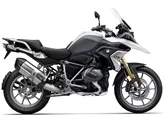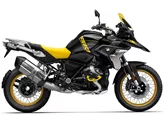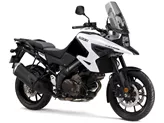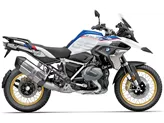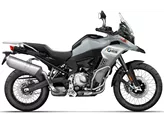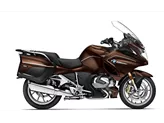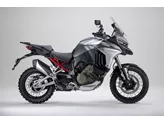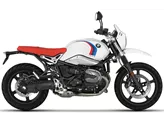BMW R 1200 GS 2017 vs. Triumph Tiger 800 XC 2014

BMW R 1200 GS 2017

Triumph Tiger 800 XC 2014
Overview - BMW R 1200 GS 2017 vs Triumph Tiger 800 XC 2014
The BMW R 1200 GS 2017 and the Triumph Tiger 800 XC 2014 are both popular enduro motorcycles, but they have several key differences in terms of their technical specifications and strengths and weaknesses.
In terms of engine and drive train, the BMW R 1200 GS 2017 is equipped with a Boxer engine, while the Triumph Tiger 800 XC 2014 has an in-line engine. The BMW has a larger bore of 101 mm compared to the Triumph's 74 mm, which contributes to its higher engine power of 125 HP compared to the Triumph's 95 HP. The BMW also has a higher torque of 125 Nm compared to the Triumph's 79 Nm. The transmission on the BMW is a prop shaft, while the Triumph uses a chain. The BMW has 2 cylinders and a displacement of 1170 ccm, while the Triumph has 3 cylinders and a displacement of 799 ccm.
In terms of suspension, the BMW R 1200 GS 2017 has a front suspension strut, while the Triumph Tiger 800 XC 2014 has an upside-down telescopic fork. Both bikes have a steel frame, but the BMW's frame is a twin tube load-bearing engine type, while the Triumph's frame is tubular.

BMW R 1200 GS 2017
In terms of dimensions and weights, the BMW R 1200 GS 2017 has a front tire diameter of 19 inches, a rear tire width of 170 mm, and a rear tire diameter of 17 inches. The Triumph Tiger 800 XC 2014 has a front tire diameter of 21 inches, a rear tire width of 150 mm, and a rear tire diameter of 17 inches. The BMW has a slightly shorter wheelbase of 1507 mm compared to the Triumph's 1545 mm. The seat height on the BMW is 850 mm, while the Triumph has a slightly lower seat height of 845 mm. The BMW also has a larger fuel tank capacity of 20 liters compared to the Triumph's 19 liters.
In terms of strengths, the BMW R 1200 GS 2017 is praised for its mature concept, strong engine, and easy handling. It also has powerful brakes, adjustable modes and traction control, and an extensive equipment range. The BMW has a good image and value retention, making it a popular choice among riders.
On the other hand, the Triumph Tiger 800 XC 2014 is known for its lively engine and sporty but comfortable chassis. It is also praised for being very easy to handle and offering lots of practical benefits. The Triumph has a great price/performance ratio, making it a more affordable option for riders.

Triumph Tiger 800 XC 2014
However, both bikes have their weaknesses. The BMW R 1200 GS 2017 has many features that come at an extra cost, which can be a drawback for some riders. Additionally, the boxer engine on the BMW is exposed in really tough terrain, which may limit its off-road capabilities.
The Triumph Tiger 800 XC 2014 has a spartan dashboard and the on-board computer cannot be operated from the end of the handlebar, which may be inconvenient for some riders. The wind and weather protection on the Triumph is also not as great compared to the BMW.
In conclusion, the BMW R 1200 GS 2017 and the Triumph Tiger 800 XC 2014 have their own unique strengths and weaknesses. The BMW offers a more powerful engine and a wider range of features, while the Triumph provides a sportier and more affordable option. Ultimately, the choice between the two will depend on the rider's preferences and priorities.
Technical Specifications BMW R 1200 GS 2017 compared to Triumph Tiger 800 XC 2014
Pros and Cons in comparison
Pros and Cons in comparison
BMW R 1200 GS 2017

For over 35 years, BMW has continued to expand the boxer range and is consistently working on the evolution of the GS. In addition to the EURO4 update of the engine with new catalytic converter and mapping, there are now even more features such as the Dynamic ESA Next Generation with automatic riding position compensation, which further improves stability and comfort for the rider. With its subtle colour scheme, the Exclusive version is intended for friends of a neat and subdued appearance and, unlike the flashier Rallye variant, is designed more for the road. Many features are at extra cost, but GS customers usually don't care - 90 percent are ordered with full equipment.
Triumph Tiger 800 XC 2014

I like the Tiger 800 XC not only on the road for my daily commute to work. It is a very uncomplicated vehicle which, thanks to the powerful and lively engine, is not only very useful but also a lot of fun. On the racetrack, I actually only used the vehicle for my instructor work. But I couldn't help it and had to take to the track once in the faster group. The high-quality chassis and the agile engine were a joy to ride and the Tiger 800 XC is THE universal talent par excellence for me.
Price Comparison Avarage Market Price BMW R 1200 GS vs Triumph Tiger 800 XC
There are a few key differences between a BMW R 1200 GS 2017 and a Triumph Tiger 800 XC 2014. There are the same number of bikes of both models available on the 1000PS.de marketplace, specifically 84. It takes less time to sell a Triumph Tiger 800 XC with 48 days compared to 72 days for the BMW R 1200 GS. Since model year 2005 1000PS.de editors have written 98 reviews for the BMW R 1200 GS and 16 reviews for the Triumph Tiger 800 XC since model year 2011. The first review for the BMW R 1200 GS was published on 1/20/2004 and now has more than 19,100 views. This compares to more than 8,200 views for the first review on Triumph Tiger 800 XC published on 11/1/2010.



